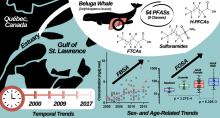| Title | Occurrences of three classes of antibiotics in a natural river basin: association with antibiotic-resistant Escherichia coli. |
| Publication Type | Journal Article |
| Year of Publication | 2014 |
| Authors | Zhang, Q, Jia, A, Wan, Y, Liu, H, Wang, K, Peng, H, Dong, Z, Hu, J |
| Journal | Environ Sci Technol |
| Volume | 48 |
| Issue | 24 |
| Pagination | 14317-25 |
| Date Published | 2014 Dec 16 |
| ISSN | 1520-5851 |
| Keywords | Anti-Bacterial Agents, China, Drug Resistance, Bacterial, Environmental Monitoring, Escherichia coli, Fluoroquinolones, Rivers, Sulfonamides, Tetracyclines, Waste Water, Water Pollutants, Chemical |
| Abstract | To investigate the occurrence of antibiotics in urban rivers and their association with antibiotic-resistant Escherichia coli, 20 (fluoro)quinolone antibiotics (FQs), 16 tetracycline antibiotics (TCs) and their degradation products, and 25 sulfonamides (SAs) and some degradation products were determined in 45 river samples and 13 discharged wastewater samples collected from Wenyu River and its tributaries and 4 composite effluent samples from sewage treatment plants in Beijing, China. Fifteen FQs, eight TCs, including four degradation chemicals, and sixteen SAs, including four acetylated products, were detected in the river water. The SAs were the dominant antibiotic (total concentrations up to 3164.0 ng/L) in river water, followed by FQs (1430.3 ng/L) and TCs (296.6 ng/L). The sum concentrations for each class of detected antibiotic in the 13 discharge site samples were higher than those in river samples, up to 12326.7 ng/L for SAs, 6589.2 ng/L for FQs, and 730.1 ng/L for TCs, largely contributing to the high concentrations in the river basin. Log-linear regression analysis confirmed that the concentrations of FQs, TCs, and SAs in the Wenyu River basin were strongly correlated with the number of E. coli resistant to FQs (p < 0.05), TCs (p < 0.05), and SAs (p < 0.05), providing evidence for the environmental impacts of antibiotic usage. |
| DOI | 10.1021/es503700j |
| Alternate Journal | Environ. Sci. Technol. |
| PubMed ID | 25427067 |
Environmental Chemical Biology

